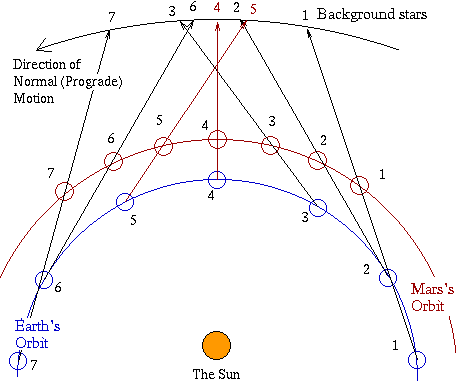|
to Galileo Kepler's Laws (For teachers) and First Law |
|
|
|
to Galileo Kepler's Laws (For teachers) and First Law |
|
 |
| Schematic drawing of the apparent reversal of motion (retrograde motion) observed with Mars. Positions 1...7 of the Earth correspond to positions 1...7 of Mars, which moves more slowly. As the Earth overtakes Mars (positions 4 and 5) the planet's position in the sky moves backwards. |
|
Today we undestand all that very well (see image above). Planets are spherical objects like Earth--Venus, Mercury and Mars are smaller, Jupiter and Saturn much bigger. Earth is a planet too and others exist as well (too faint to be seen without a telescopes), all orbiting the sun on or near the plane of the ecliptic. Their speed however varies--the closer to the Sun, the faster (see section 10a and in particular Kepler's third law). Therefore, when the three outer planets are near opposition, the Earth orbiting closer to the Sun overtakes them, and they seem to move backwards. The retrograde motion of the two inner planets has a similar cause. Being closer to the Sun, they overtake the Earth in their motion. Summary of what is now known about Planets
Early History, False LeadsAs noted earlier, Aristarchus of Samos proposed that the Earth revolved around the Sun, but the idea was rejected by later Greek astronomers, in particular by Hipparchus. Ptolemy, living in Egypt in the 2nd century AD, expressed the consensus when he argued that all fixed stars were on some distant sphere which rotated around the Earth. Ptolemy tried to assemble and write down all that was known in his day about the heavens in "The Great Treatise," now known as the "Almagest," a corruption of its Arab name.
To explain the motion of planets, Ptolemy used a theory which started with Hipparchus. The work of Aristarchus and Hipparchus had already established that the Moon moved around Earth. Ptolemy assumed that the Sun, planets and the distant stars (whatever those were) also moved around the Earth [but not everyone agreed ]. To the Greeks, the circle represented perfection, and Ptolemy assumed Moon, Sun and stars moved in circles too. Since the motion was sometimes slower, sometimes faster [as later expressed in Kepler's 2nd law, sect.#12a], he assumed that these circles were centered some distance away from the Earth. While the Sun moved around Earth, planets moved on circles around points that rotated around Earth once a year (today we realize Venus and Mercury actually orbit the Sun, which is why their positions never stray far from it). But what about Mars, Jupiter and Saturn? Cleverly, Ptolemy proposed that like Venus and Mercury, they also rotated around points in the sky that were carried around Earth, but with longer periods. The center carrying each of those planets accounted for the planet's average motion, but to this the planet's own motion around its center had to be added, and sometimes the sum of the two made the planet appear (for a while) to advance backwards. The backtracking of the planets now thus explained. The main motivation behind early models of planetary motion was astrology, the superstitious divining of human fate from positions of planets at pivotal moments, e.g. birth. The models left open the questions of what the planets were, what the Sun and Moon were, and why they displayed their strange motions. Worse, they were also somewhat inaccurate. Yet Ptolemy's view of the solar system dominated European astronomy for over 1000 years. One reason was that astronomy almost stopped developing during the decline and fall of the Roman Empire and during the "dark ages" that followed. The study of the heavens continued in the Arab world, under Arab rulers, but of all the achievements of Arab astronomers, the one which exerted the greatest influence was the preservation and translation of Ptolemy's books, and thus of their erroneous views.
It belongs to a set of lesson plans whose home page is at Lintro.htm. Questions from Users: *** Ptolemaic Theory of Planet Motion |
The first of 14 sections on members of the solar system:
(P-1) The Solar System--Links and Tables
Or else, the main story continues at:
#9c The Discovery of the Solar System
Timeline Glossary Back to the Master List
Author and Curator: Dr. David P. Stern
Mail to Dr.Stern: stargaze("at" symbol)phy6.org .
Last updated: 2 April 2014